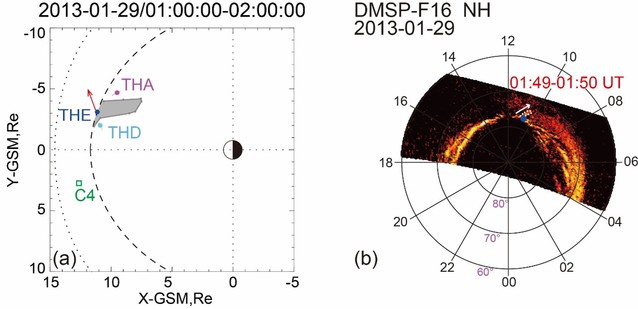HuiXuan Qiu1, De-Sheng Han1*, BoYi Wang2, HuiTing Feng1, Bin Li3, Su Zhou4, Run Shi1, HuiGen Yang3,1, and Y-L. Zhang5
1 State Key Laboratory of Marine Geology, School of Ocean and Earth Science, Tongji University, Shanghai, China
2 Institute of Space Science and Applied Technology, Harbin Institute of Technology, Shenzhen, China
3 MNR Key Laboratory for Polar Science, Polar Research Institute of China, Shanghai, China
4 School of Electronics and Communication Engineering, Guiyang University, Guiyang, China
5 The Johns Hopkins University Applied Physics Laboratory, Laurel, MD, USA
Abstract
Throat auroras have been suggested to correspond to magnetopause indentations, but how such indentations can be generated is an open question. Using coordinated magnetopause in situ and two-dimensional auroral imaging observations, we showed that a transient magnetopause crossing observed by THEMIS near the dayside magnetopause corresponds to a throat aurora observed by DMSP/SSUSI. The magnetopause crossing was confirmed to present a localized magnetopause indentation rather than arise from motion of the whole magnetopause. Using the minimum variance analysis and Walén test methods, we captured clear reconnection signatures at either boundary of the indentation. Also, an upstream solar wind discontinuity and a magnetosheath variation were identified to correlate well with the magnetopause indentation occurrence. These observations suggest that the magnetopause indentation was generated by reconnection and lend solid support to an assumption that throat aurora is produced by a particular reconnection that can develop inward the magnetosphere at a much-localized region.
Full Article: https://doi.org/10.1029/2022GL099408



